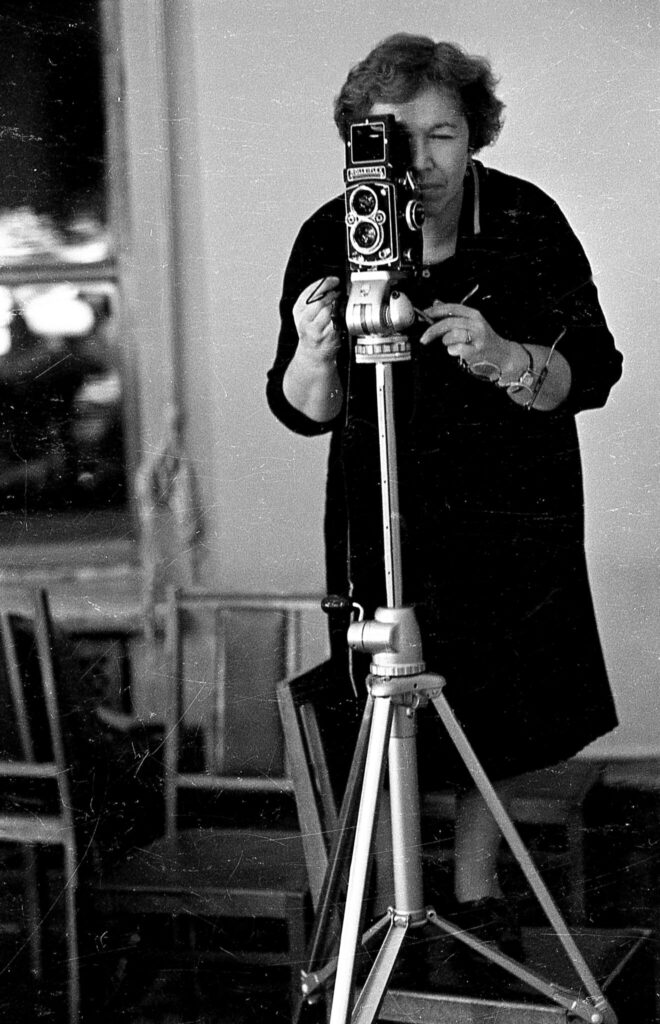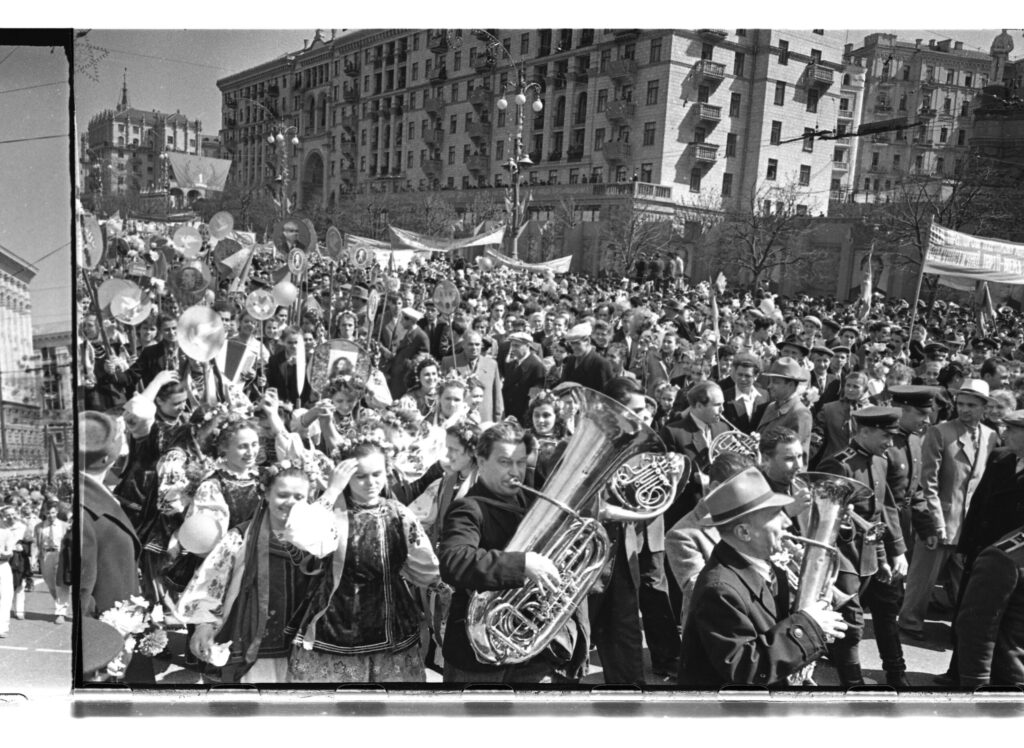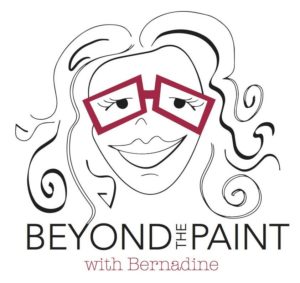Historically, Ukrainian art history books have “failed to give Ukranian women artists their due.” This episode looks to two 20th century women artists who left an idelible impact on the story of art in Ukraine: Early 20th century Modernist: Alexandra Exter and mid-20th century photographer Iryna Pap.
This episode is an entryway to an upcoming series of conversations with contemporary, female artists of Ukraine: Figurative painter Iryna Maksymova, Surrealist painter Rita Maikova and the American artist Nicole Peyrafitte. They are part of the exhibition, “Women and Other Wild Creatures: Matrilineal Tales,” curated by Dr. Nina Levent, at the Sapar Contemporary Art Gallery in New York.
Resources for this episode include:
- Bowlt, John E. and Drutt, Matthew. “Amazons of the Avant-Garde: Alexandra Exter, Natalia Goncharova, LIubov Popova, Olga Rozanova, Varvara Stephanove and Nadezhda Udaltsova. New York: Guggenheim Museum, Publisher, 2000.
- Heller, Nancy. “Women Artists: An Illustrated History.” New York: Abbeville Press, 1987.
- Iryna Pap: https://56store.com.ua/en/catalog/irina%20-pap
- Featured Image: Alexandra Exter, “Color Rhythms,” oil on canvas




Script: Welcome to Episode 162: Avant- Garde Women Artists of Ukraine: Alexandra Exter and photographer Iryna Pap.
Hello my art enthusiasts! This episode is entryway into a series of upcoming episodes celebrating contemporary female artists from Ukraine. They are part of a group exhibition, “Women and Other Wild Creatures: Matrilineal Tales” at the Sapar Contemporary gallery in New York. I had the privilege of meeting with the founding director of Sapar and curator of the exhibition, Dr. Nina Levent, to view the show in person. For Dr. Levent, this exhibition is very personal. She is from the Ukraine and has family living there. The launch of a military invasion from Russia of Ukraine this year directly impacts her close family relations. It is heartbreaking. The exhibition is Levent’s poetic gesture, her creative expression to bring visibility to the resilience and strength of the Ukrainian community, especially women. Proceeds from the works in the exhibition will benefit charities in the Ukraine. Over the summer, I will be recording conversations with 3 of the women artists in the show. Figurative painter: Iryna Maksymova, Surrealist painter: Rita Maikova, and the American mixed-media artist Nicole Peyrafitte.
In this episode I want to journey with you two women avant-garde artists born in the Ukraine and their indelible contributions to visual art world, paving a foundation of exposure for women artists of Ukraine. 20th century Modernist Alexandra Exter, and the mid-20th century photographer Iryna Pap. I was inspired to create this “introductory” episode from an essay by the editor of the book “Why There Are Great Women Artists in Ukrainian Art,” Kateryna Iakovlenko. She asserts, “Ukrainian art history books have long failed to give Ukrainian women artists their due. Some have even wondered whether women artists even existed.” The text, published in 2019, (side note: the title of the book is a deliberate recall of the American feminist critic Linda Nochlin’s famous essay, “Why have there been no great women artists,”) “sets out to restore justice to Ukraine’s women artists.” Art Historians, asserts Iakovlenko, “viewed these women artists predominantly as partners to men. According to them their proper place as artists has been hampered by an unexamined belief that Ukrainian art was a masculine field, one in which women, lacking sufficient talent, simply could not survive. But the true bars to women’s participation at the same level as men were chiefly political and economic. Even during the harshest periods in Ukraine’s history, such as at the beginning of the twentieth century or in the 1990s, in the chaotic days following independence, women artists were present in Ukraine’s art life: they created artworks, mounted exhibitions, and taught art in university classrooms. This resilience to making work is resonant and frankly very inspiring for me.
The book focuses on the 20th century with many women artists starting their careers at the Academy of Art in Kyiv, (founded in 1917) “The initial faculty at the Academy counted, as far as we can determine, one woman artist, Alexandra Exter, born in 1882, died in 1949, who for many years split her time between Kyiv and Paris.” And though she moved frequently between St. Petersburg, Moscow, Venice, and Paris, she always returned to Kyiv, to her studio, family and home. The city of Kiev was an important motif in her paintings. It is important to note that Kiev in the late 19th century, early 20th century was insulated and distant from the cultural mainstream of Russia and the West. Exter did all she could “to transplant new and experimental ideas directly onto Ukrainian soil.” Trends like Cubism, Neo-Primitivism. Exter helped to organize avant-garde exhibitions, and in 1910 the International Salon. A major artistic event, the International Salon, traveled from Odessa to Kiev bringing European modernists, including Henri Matisse to the public. Exter helped to maintain Kiev as a major center for artistic experiment bringing together artists, writers, and the theater community. Exter was known to nurture emerging artists.
Imagine for a moment the vibrancy of artistic thought and experimentation in Kiev at this time in the earlier part of the 20th century. Influenced by Europe’s evolving artistic style and trend Cubism.
I want to digress for just a moment—to give an overview to those who do not know of Cubism as a style and movement. Cubism, “invented jointly by Pablo Picasso and Georges Bracque challenged some of the most fundamental tenets of Western art with a wholly new approach to painting. In essence Cubism analyzes form, geometricizing figures and other representational objects, collapsing traditional naturalistic notions of depth and perspective. In the painting, oil on canvas, from 1910, “The Guitarist,” takes apart or disassembles the figure, the guitar into forms. Picasso creates a new language of representation that embraces two-dimensionality versus the illusion of three-dimensionality through perspective, light and shadow. He simplifies the forms into diagonal, horizontal, vertical lines rendered in black. He reduces the color into pale tones of browns, whites alongside the contour black lines.
Cubism was developed in France. In the early 20th century Paris was the focal point for avant-garde activity. Russia also produced major modernist pioneers, some of the first nonrepresentational paintings came from Russia. There was a great deal of interaction among Russian artists including those of Ukraine and Western Europe. Many will flee to Europe and the United States in the early 1920s as the Soviet government “decrees that the purpose of all art was to serve the state—their preferred style was Social Realism, not the experimentation with abstraction.
Exter, as I noted earlier did travel to centers of Russia and in Europe, including Paris. She was a female artist, who unlike other artists, including her female contemporaries did not “study” this new artistic visual language, Cubism through formal classes. She “learns Cubism through personal contact with its inventors.” Picasso and Braque. The challenge she found, what Exter “found difficult to accept was what the Cubists were saying about color or how they were applying it or not applying it. You see, to Exter, color was everything. It was the “alpha and omega of the art of painting. Explosions of color are a characteristic feature of Exter’s abstract, Cubist paintings.
Let’s look at one example: “City,” oil on canvas, 1913, a non-objective work, with no figures, Exter constructs scene of a Cubist style, an urban scene, geometric forms are arranged through carefully “worked out aesthetic principles,” with angular lines—the geometric forms suggest an affinity with Ukrainian ornament. Each form bursts with a vitality of colors, in the center of the composition, there is a series of arranged rectangular planes, a blue rectangular plane coupled with a red and white one and similar combinations funnel upwards towards the top of the canvas. On the sides are renditions of buildings through a few lines and in between are rounded mounds of vibrant green.–whereas Cubist’s works by Picasso “form absorbs color.” Exter’s colors are emphasized and overflow the canvas. There is an element of movement echoing the rhythm of the urban scene. Exter described her abstract paintings using terms from physics such as speed, acceleration, vector, mass, energy, and direction. There is nothing static in her paintings; she creates “almost hypnotic impression of constant change and evolution.” Yet, the painting and similar works express her personal affinity and experiences with what was close to home, the cityscape of Ukraine, of Kyiv.
“The second half of the twentieth century saw little improvement in conditions for women artists in Ukraine. That assertion is referenced in the Iakovlenko text. Highlighted are Iryna Pap and her husband Borys Gradov who formed a photographic tandem in Soviet Kyiv while working for different clients. Both were great photographers, but Iryna remained in the shadow of her husband’s fame.
Let’s take a close look at Pap and her photographic works. Born Freida in 1917 in Odessa, Ukraine, she died in 1985. She was an Ukranian Soviet photojournalist, one of the few female photojournalists, working for the newspaper Izvestia, between 1958 and 1970. Pap was the first granted approval to take aerial photography of Kiev’s reconstructed streets after WWII, and even ventured inside of a nuclear reactor turbine in her search of a better shot. Her work at the newspaper is considered a profound source of knowledge about life in the USSR. Pap’s tenure coincided during an era of major infrastructural construction, economic growth, space exploration. “It is in a way an official history written in the photographic language.”
In 1970 she founded and led the Institute of Journalism at the Ukraine’s Union of Artists. Pap is considered one of the best female photojournalists and photographers.
“Her power stems from the access she got for herself, the vantages she worked from and her unbreakable spirit and fearlessness. She is described as, and I love this quote, “of being of short stature, with a camera, Pap clawed her way through the chunky bodies of her male colleagues in order to take the best shot” Love that boldness, that sass! Her legacy of works is described as two archives that illuminate two Russia; a carefree Russia and “an impermissible and hidden one.” When Pap left the newspaper in 1970 and founded and led the first professional school of photojournalism, the Institute of Journalism, there was an increased pressure on creative intellectuals with a growing number of arrests and persecutions.” Through this time, however, Pap never stopped taking photographs. The latter series of works were never published during her life time. It is only through the archival work of photographer Valery Milosercov, Pap’s work and talent have come to light in recent years.
Let’s look at two images from her tenure at Izvestia newspaper to get a sense of her perspective and aesthetic. In the photograph, “Celebration at May 1,” from 1958 in Kyiv, we see a black and white image of a parade on a city street. In the foreground are a group of men in suits, one man is in an overcoat, another wears a jacket and cap. They are blowing into tubas. Young girls in peasants’ dresses, flower in their hair, and file behind. To the right, bystanders are crammed together, flowing in to the street. There is no sense of uniformity. It is a joyous chaos of a collective of lives, living. In another image from 1965, young children, at least a dozen sit on a long bench on a city street. They look away from the viewer laughing at some activity or person just outside the frame. In the background we partially see storefront shops and the tops of groomed trees.
I did not have a lot of knowledge of Ukraine women artists, the avant-garde modernist Alexandra Exter or the mid-century photographer Irinya Pap. Both lived and worked through wars, political unrest and control and yet, through resilience, strength, determination, created works that exposed new perspectives and possibilities. Thankfully, women artists in Ukraine today have achieved relatively high visibility. No longer are their histories being shrouded. Women like the curator Dr Nina Levent expose the creative, exciting female artistic voices through their platforms. For me, it is the audio journey of this podcast. Stay tuned for my conversations with three female artists from the exhibition .“Women and Other Wild Creatures: Matrilineal Tales” at the Sapar Contemporary gallery in New York, up until August 26, 2022. Resources and links to the exhibition are in the podcast notes. If you enjoyed this episode, please like and leave a review on Apple, Spotify or wherever you get your podcasts. Your support helps to bring awareness to the show. Special thanks to Beyond the Paint with Bernadine sponsor, Nine 90 Branding and Design. Thank you!
